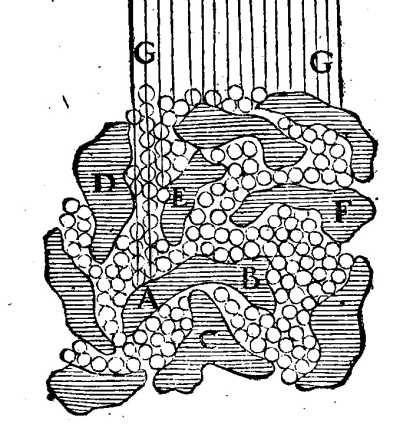How Does Light Move Air Particles?
Table of Contents
28. The Third Action: Light – How Does Light Move Air Particles?
The force of the light from the Sun and stars spread to all parts of the sky.
The sun’s rays interact with the earth-aether particles in various ways.
These rays exert a straight-line pressure from the Sun to the Earth.
This pressure is not applied uniformly to all particles of the earth-aether in the upper region of the Earth.
This creates various motions in these particles.
For example, if AB is an earth-aether particle in the upper region of the Earth, leaning towards another particle C, with many other particles like D, E, F interspersed between them.

These intervening particles may hinder the Sun’s rays G, G from pressing on the extremity B but not on A.
Thus, the extremity A will be depressed, and B will be raised.
These particles constantly change their positions. Shortly afterwards, they will be opposed to the Sun’s rays tending toward A, but not to those tending toward B.
Consequently, the extremity A will rise again, and B will be depressed.
The same happens with all Earth particles reached by the Sun’s light, and hence, all are moved by the light.
29. The Fourth Action: Heat - how it persists after light is removed
This agitation of earth-aether particles*, whether originating from light or any other cause, is called heat, especially when it is greater than usual and affects the senses.
Superphysics Note
The designation of heat is related to the sense of touch.
Each of these earth-aether particles, once set in motion, persists in its motion according to the laws of nature until it is stopped by some other cause.
This is why the heat originating from light continues to exist for some time after the light is removed.*
Superphysics Note
30. Why heat penetrates deeper than light
The earth-aether particles, impelled by the Sun’s rays, agitate others nearby to which these rays do not reach. These, in turn, agitate others, and so on.
The entire half of the Earth is always illuminated by the Sun.
So many of these earth-aether particles are set in motion that their heat penetrates to the innermost parts of the middle region of the Earth.*
Superphysics Note
31. Why heat decompresses almost all bodies
When agitated by more than usual heat, these earth-aether particles cannot be contained in the usual narrow space as when they are at rest or less in motion.
This is because they have irregular shapes.
- They occupy less space when connected in a certain way and at rest than when they are continually moving and separating.
Thus, heat decompresses almost all terrestrial bodies to varying degrees depending on the arrangement and shape of the particles they are made of.*